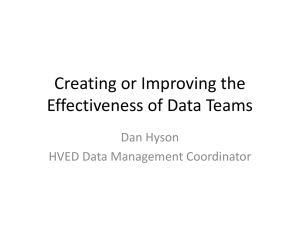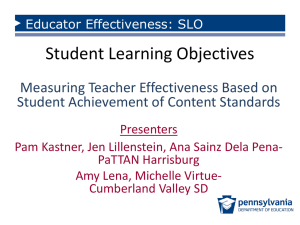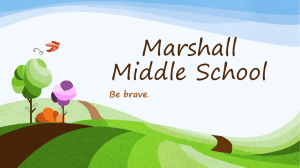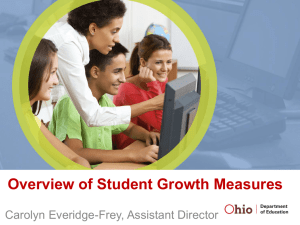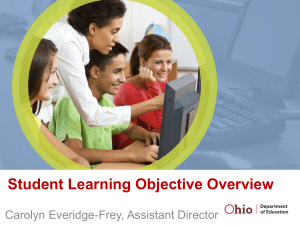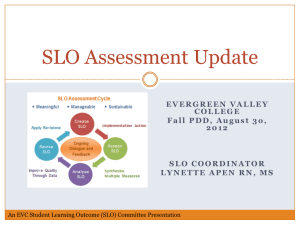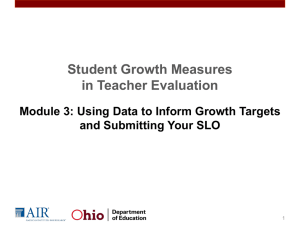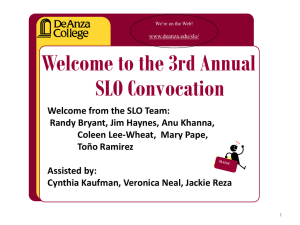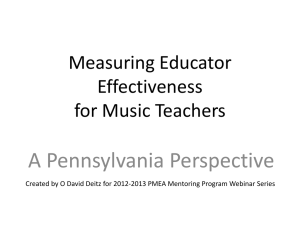SLO Powerpoint - Upper Perkiomen School District
advertisement
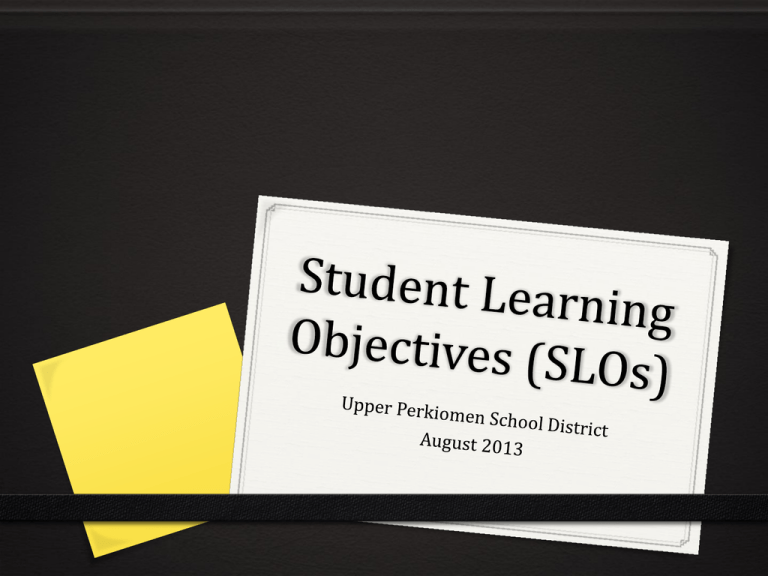
Measurement of Student Achievement Measurement of Educator Effectiveness SLO Concepts • Student achievement can be measured in ways that reflect authentic learning of content standards. • Educator effectiveness can be measured through use of student achievement measures. 1. Know and understand the Standards 0 PA Standards 0 Common Core Standards 0 Professional/Technical Standards 2. Assessment Tasks 0 Authentic to the grade or course 0 Aligned to Standards 3. Assessment Scoring 0 Can describe levels of student achievement toward standards based learning objectives THE PA SLO TEMPLATE & PROCESS What it is supposed to be: What it is not supposed to be: • A format to inform strong instructional practice and strong student achievement 0 More paperwork for • teachers More paperwork that for has no teachers that has no meaning or purpose meaning or purpose 0 More testing for • A way to measure teacher effectiveness based on student achievement • students More testing for students • An opportunity for teachers to define, describe and present data on student achievement in the content area that they teach • A weak substitute for standardized testing PVAAS or other data standardized testing data 0 A weak substitute for PVAAS or other Educator Effectiveness: SLO PA Educator Challenge To develop and implement an appropriately rigorous measure of teacher effectiveness based on student achievement in your content area through the use of the PA SLO Template. www.education.state.pa.us > Educator Effectiveness: SLO STUDENT LEARNING OBJECTIVE TEMPLATE A format to provide a measure of teacher effectiveness based on student achievement of content standards, as applicable to the “Elective Data” portion of the Teacher Effectiveness System in Act 82 (HB 1901). www.education.state.pa.us > Looking at the Components of PA’s SLO Template Teacher Information Content Area Student Learning Objective Data and Targets Used to Establish the SLO Assessment/Performance Task Administration of the Assessment/Performance Task Evidence of Individual Student Achievement Strategies/Actions to Achieve the SLO Teacher Effectiveness Measure (Rating) 9 • Implementation Timeline • • • • • • • • 9. Teacher Effectiveness Measure Classroom Objective How will the aggregated scores of the “Evidence of Individual Student Achievement” results be used to define teacher effectiveness? Failing: few students achieve content mastery or growth Needs Improvement: less than a significant number of students achieve content mastery or growth Proficient: A significant number of students achieve content mastery or growth Distinguished: An exceptional number of students achieve content mastery or growth Grade 1 Math Using the AIMSweb MComp assessment, less than 64% of students will meet or be above benchmark (or green). Using the AIMSweb Early Numeracy assessments, less than 64% of students will meet or be above benchmark (or green). Using the AIMSweb MComp assessment, 65%-79% of students will meet or be above benchmark (or green). Using the AIMSweb Early Numeracy assessments, 65%79% of students will meet or be above benchmark (or green). Using the AIMSweb MComp assessment, 80%-89% of students will meet or be above benchmark (or green). Using the AIMSweb Early Numeracy assessments, 80%90% of students will meet or be above benchmark (or green). Using the AIMSweb MComp assessment, 90%-100% of students will meet or be above benchmark (or green). Using the AIMSweb Early Numeracy assessments, 90%100% of students will meet or be above benchmark (or green). Grade 8 Art Fewer than 70% of students achieve proficient or advanced levels (holistically) on two out of three project rubrics. 70% to 85% of students achieve proficient or advanced levels (holistically) on two out of three project rubrics. 85% of students achieve proficient or advanced levels (holistically) on two out of three project rubrics. 85% of students achieve proficient or advanced levels (holistically) on all three project rubrics. Targeted Objective How will the mastery or growth of targeted student populations be described and used to define teacher effectiveness? Failing: Did not meet goal, little to no student mastery or growth Needs Improvement: Did not fully meet goal but showed some student mastery or growth Proficient: Met goal or otherwise demonstrated significant student mastery or growth Distinguished: Surpassed goal or otherwise demonstrated significant student mastery or growth Grade 1 Math Targeted Population: Students who did not enter at grade level. Mastery and/or growth goal: Students will maintain or improve their performance level as assessed using the AIMSweb M-Comp and TEN probes. Grade 8 Art Targeted Population: : Four students who demonstrated an inability to remain engaged and complete projects during their prior courses in middle school art, resulting in no projects receiving proficient rating. Mastery and/or growth goal: To complete a minimum of one of the three projects to a proficient level, with the other two projects completed to no less than the basic level. 7. Evidence of Student Achievement Guiding Questions: In what format will data be collected (e.g., database, graphed, portfolio, etc.) Is a pre-post test being used? (If so, please describe.) How frequently will data be collected? Data Collection Sample Statements: Grade 1 Math: Probes are teacher scored, and data from all probes administered will be put input into a database. Grade 8 Art: The scores from student rubrics will be into entered into a database format. Data is collected at the conclusion of each project. 7. Evidence of Student Achievement Guiding Questions: How was baseline data collected? (If baseline data was not collected, please explain.) Can baseline data be compared with the results of this assessment/performance task? Scoring Student Progress/ Sample Statements: Preparation Grade 1 Math: Since the assessments describe mastery, no baseline data is required. However, the design of the assessment system is one of ongoing assessment, data collection and subsequent progress monitoring. Grade 8 Art: As this is a mastery assessment, no baseline data is collected. 7. Evidence of Student Achievement Guiding Questions: What evidence will be presented to principal/evaluator to support the teacher effectiveness measure? How will data be presented to the principal/evaluator (e.g., database, graphed, portfolio, individual student artifacts, etc.)? Data Presentation Sample Statements: Grade 1 Math: Evidence will be presented through aggregated scores from the database. Grade 8 Art: Results of the database will be presented to the principal. Student artwork exemplars will also be available if requested. 7. Evidence of Student Achievement All Grades and Courses: The assessment can be scored by an equivalent peer. All Grades and Courses: The assessment is a commercially produced assessment that has a history of validity and reliability. Data Analysis and Interpretation Guiding Questions: How can the assessment/performance task results be interpreted in the same way across equivalent peers? Is there a reliable and valid scoring and interpretive process (i.e., state developed, district-based, commercial, standardized, etc.) that is associated with the assessment/performance task? If so, please describe. Sample Statements: Grade 1 Math: AIMSweb M-COMP and TEN are valid and reliable commercially developed assessments. Grade 8 Art: An equivalent peer can use the rubrics to assess the projects. 8. Strategies/Actions to Achieve the SLO Guiding Questions: What formative assessment information lets you know if your instructional practices will lead to successful completion of the SLO? Assessment for Sample Statements: Learning Grade 1 Math: AIMSweb is a progress-monitoring process that includes benchmark assessments. Grade 8 Art: Students will use the project assessment rubrics as a part of the ongoing process. The teacher will work with students to develop strength in formative self-assessment. 8. Strategies/Actions to Achieve the SLO Guiding Questions: Based upon reflection, what instructional practices would you like to change or strengthen? What professional learning and/or other type of support will help you to achieve this SLO? Alignment Sample Statements: with the Grade 1 Math: Based on the formative assessment information Danielson provided by the AIMSweb probes, I will intentionally modify Framework groupings periodically to provide more targeted instructional process for and materials toward both remedial and deeper understanding Teaching (based on Webb’s Depth of Knowledge). (Danielson 3C) Grade 8 Art: In an effort to link higher achievement with engagement in art beyond the classroom, I will work to provide students with content related yet diverse project options that have computer processes embedded, giving more access for students to identify and create their own learning materials. (Danielson 3C) Let’s look at an example and some criteria 0 8th Grade Science SLO Sample Draft 0 Criteria for High-Quality Assessments http://nassauboces.org/Page/1667 http://www.riseindiana.org/sites/default/files/files/RISE%201.0/Student%20Le arning%20Objectives%20Handbook%201%200%20FINAL.pdf http://www.ride.ri.gov/EducatorQuality/EducatorEvaluation/SLO.aspx http://www.gadoe.org/School-Improvement/Teacher-and-LeaderEffectiveness/Documents/SLO%20Manual.pdf WHAT DOES THIS ALL MEAN FOR UPSD? 0 Focus of district In-Service Days 0 Incorporated into curriculum work and PLC work; “Begin with 0 0 0 0 the end in mind” – what do we expect all students to know, understand, & be able to do? How can they demonstrate? (Beyond state assessments or similar type assessments?) Allow us to revisit/solidify Grading Policies & Procedures Connect to Differentiated Supervision Options; SLO development must be linked to Danielson Framework and must influence growth in some aspect of professional practice. Support teachers (Reading Specialists, Learning Support) – SLOs for students served. REMEMBER: Student performance on the assessments from SLOs will be part of teacher evaluation – 20 %– 35% HOW WILL WE MOVE FORWARD? 0 State-assessed content areas– what part of overall assessment is NOT represented in state assessments that we do or will include in our assessment of students? 0 Non-Assessed – what assessment do we want to use for SLO; mastery or growth; all students or specific population? mastery or growth; all students or specific population? 0 Brainstorm and determine by grade/course; share with Director of T & L and Building Administrator 0 Can this or how can this fit into supervision mode? HOW WILL WE MOVE FORWARD? 0 Begin brainstorming process this week 0 Curriculum Committee Groups – will incorporate into curriculum work 0 In-Service Day – November 5th: Focus on developing draft SLOs for each subject area and/or grade level (at the elementary level, I do not believe SLOs need to be developed for all core academic areas; more related to Elective data piece for teachers). 0 Technology – how can we use to technology as part of this process? PLEAE REMEMBER 0 We are all in this together! 0 We have a choice on how we approach this work! 0 We do no have all the information, but we do know we cannot ignore it; it is not going away. 0 We will use this to do what we have always done – what is best for our students’ learning and growth! QUESTIONS?


